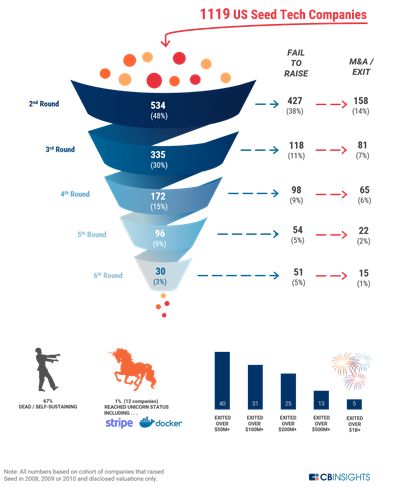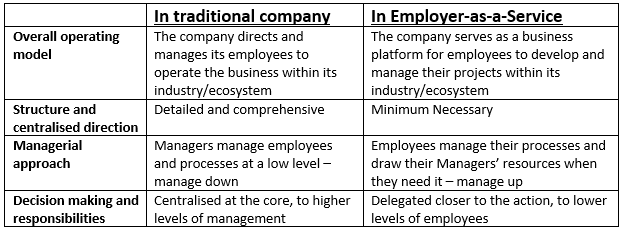Employer-as-a-Service for attracting entrepreneurial talent
Business incumbents have a problem: entrepreneurial people do not want to work there. Back in 2014 Wharton Business School published the paper about How to Retain and Attract Entrepreneurial Talent citing studies with the evidence that majority of entrepreneurial employees want to stay at work, but quit out of frustration of being too restricted.
On the other hand, entrepreneurs have a problem too: their start-ups go bust, quite frequently. The Venture Capital Funnel from CB Insights gives some statistics about it:

So, while entrepreneurs go their own way and establish start-ups which mostly fail, incumbents lack such talent to generate new projects for organic growth. We have a lot of books and models about corporate innovation, but the actual execution needs foremost the right people and teams.
Hence attracting and retaining entrepreneurial workforce should be a top priority, and creating a work environment for them which is preferable to a high-risk start-up activity should not be that hard. As Wharton study showed in most cases it is not the drive to “change the world” which makes entrepreneurs stay away from corporates, but the clamps the companies put on their capabilities and potential.
What do we mean by Employer-as-a-Service?
There is an operating framework which marries steady job safety offered by incumbents with the freedom-seeking spirit of entrepreneurs. Let’s call it ‘Employer-as-a-Service’. It is easier to describe it by comparing it to a traditional company with the following examples:

One might argue that this is just the culture of delegating and not micromanaging. Yes, but in addition to that, it is taking those principles to define the company identity. Formulating this model by the specific name of ‘Employer-as-a-Service’ has the following benefits:
- To employees: It signals that they are not workers to be managed around, rather, they are professionals who manage their projects and the Employer is at their “Service” to help them by providing needed infrastructure and resources
- To managers: it signals that rather than manage, their primary job is to provide a proper environment, support and resources for self-managed professionals to execute their projects
What are the real-world examples?
- In media: many newspapers serve as a playground for journalists to develop their projects/stories/articles
- In academia: universities mostly function with Employer-as-a-Service model for the professors and provide infrastructure for their research and initiatives
- You can find Employer-as-a-Service approach in companies like Pixar, Morning Star, or Medium with its Holocracy culture which later was changed but still retained many elements of it
How can you operate Employer-as-a-Service model?
Can a company operate as a full 100% Employer-as-a-Service?
No.
To clear this upfront, even the most delegated and flat company needs Minimum Necessary level of structure, centralised strategy and direction. Otherwise, it will turn into chaos. Taking this idea to a radical level will lead to utopia and failure.
Can any company have elements of Employer-as-a-Service?
Yes.
And should, by as much as possible. The centralised structure, strategy and direction should be Minimum Necessary to prevent incoherent and uncollaborative mess, and the rest should be operating like Employer-as-a-Service:
- Like in the economy, regulations should be Minimum Necessary to prevent collapse and radical inequality, and the rest should be given to the free market to figure out
- Like in parenting, rules must be minimum necessary to make children morally decent and socially acceptable, and the rest should be left to them to decide themselves
It is applying the same concept to business operating governance.
So what is that ‘Minimum Necessary’ level of structure and centralised direction?
I don’t know.
Nobody knows exactly. We all have our opinions, but formulating this point is a separate theme of Organisational Behaviour research. The purpose of this post is to simply discuss the concept.
But you don’t need to know it at the beginning: Just adopt the mindset of Employer-as-a-Service and you will notice tons of unnecessary rules and central directions restricting your employees from creating value. Eliminating those is already good progress.
If you decide to go further, make the transition to Employer-as-a-Service with small steps and the specific practices which will work for your circumstances, rather than go big right away and copy famous “good to work at” companies. Gradual implementation will over time help you find the balance point of Minimum Necessary structure which uniquely applies to you. If you just copy other glorified cultures, many elements from them will not be suitable and the disappointment from it might even lead to abandoning the approach altogether, as it happened with many who were just copying Google or generally the silicon valley start-ups.
Conclusion: Why it is important now?
We are entering a global economic recession. A lot of start-ups will have a tough time and entrepreneurs will be available for new projects. On the other hand, incumbents will have a problem of going back to growth. Bringing entrepreneurial talent to established companies will be a win-win solution for both parties and Employer-as-a-Service model can help with that.
So, give it a go as an experiment. Start by accepting Employer-as-a-Service as your personal mentality and observe the impact. Attracting and retaining entrepreneurial talent will become much easier and it will help you accelerate the growth and profitability.


